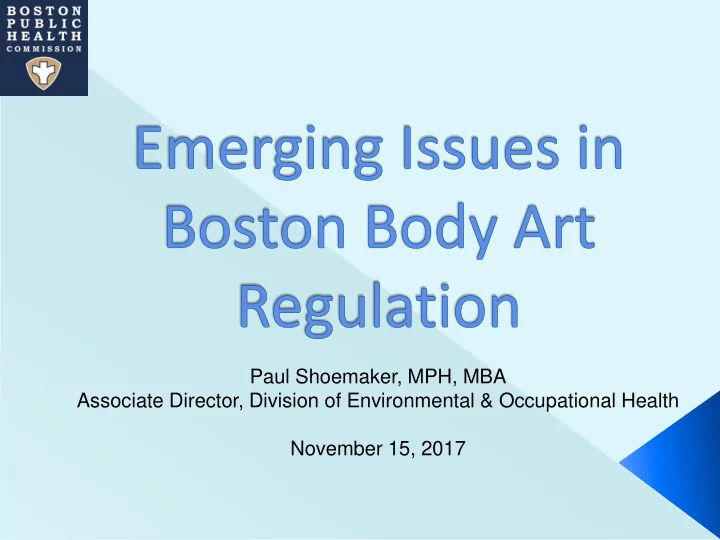

Paul Shoemaker, MPH, MBA Associate Director, Division of Environmental & Occupational Health November 15, 2017
History of the Boston Body Art Regulations Requirements of the Regulations Implementation and Enforcement Emerging Issue – Permanent Cosmetics Challenges and Lessons Learned
1962 – Massachusetts bans tattooing except by a physician 2000 – State ban ruled Unconstitutional by the MA Superior Court Jan. 2001 – MA DPH issues model body art regulations May 23, 2001 – BPHC promulgates Boston Body Art Regulations Currently 16 active body art establishments and 61 licensed artists
Restrictions on Clients Permits/Licenses – establishment and artists Physical Facility Conditions Artist Qualifications Work Practices
Under 18 – No tattooing, piercing genitalia, branding, or scarification Under 14 – No piercing at all 14-17 y/o – Piercing (except genitals) if a parent or legal guardian is present and signs a consent No body art if client impaired by alcohol or other drugs No body art on any part of a client showing a visible rash, lesion, or sign of infection Client must disclose certain medical information which the artist may use as a basis for refusing service
Annual permit required except: › licensed physician’s practice › businesses that do only ear piercing Zoning compliance and Use and Occupancy permit Floorplan separates practice area from public Emergency plan Medical waste disposal contract Clean room and sterilization equipment Restrooms and hand washing sinks
Documentation of licensure in another jurisdiction or previous practice or apprenticeship Photo ID First Aid/CPR certification Blood Borne Pathogen training certification Anatomy and Physiology course (piercer only) On- site “inspection” of work
Client consent/release statement and record keeping Sanitation of work stations Sanitation of tools – wash/ultrasonic cleaner and autoclave Single- use ink ‘caps’, bagging machine/cord, covering surfaces After-care instructions
Routine inspections Investigation of unlicensed artists/shops Licensing guest artists
Also called micropigmentation, microblading, permanent makeup, cosmetic tattooing and similar terms Definition: Using the processes and principles of tattooing to introduce ink into the skin to replicate the appearance of applied cosmetics, such as enhancing eyebrows, coloring lips, eyeliner/shadow, etc.
Until this year, prohibited in salons licensed by the MA Board of Registration of Cosmetology and Barbering (BOC). Recent BOC policy change permits permanent cosmetics in salons if they meet local regulations and use a separate room approved by the BOC Several calls each week from practitioners. inquiring about permanent cosmetics licensing Boston Regulation includes permanent cosmetics as tattooing
Policy approach: In line with state policy, provide a path to licensure for permanent cosmetics practitioners to ensure they meet the health and safety standards set out in our Body Art Regulation Key challenge: Crafting appropriate education requirements › Cosmetologists unable to meet the required documentation of prior experience in tattoo parlor › Tattoo industry trains practitioners using informal apprenticeships, cosmetology industry focuses on formal classroom education › Training classes for permanent cosmetics being offered across the country are of varying rigor
Reviewed body art regulations by state to collect the following information: › Do they have body art regulations? › What are their training requirements? › What training coursework do practitioners need? › Do they mention permanent cosmetics in their regulations? › Do they have separate permanent cosmetics regulations? › What training do they require for permanent cosmetics? Coursework? Apprenticeship?
Training requirements are set in the Guidelines Under the Body Art Regulation, Guidelines can be updated by the Executive Director Proof of experience and training for permanent cosmetics only: › Certificate of successful completion of a training course of at least 100 hours of instruction time and accredited by either the American Academy of Micropigmentation or the Society of Permanent Cosmetic Professionals; and › 200 hours of apprenticeship, including 30 hours observing procedures being performed and performing at least 50 complete supervised procedures Based on Kansas, Maine, Missouri, Virginia model
Environmental & Occupational Health will: › Notify industry professionals in tattoo shops › Notify nail salons and hair salons Modes of communication: › Formal letters › Fact sheets › In-person outreach through Safe Shops Program › Responding to in-person and phone-based inquiries, as needed
Mobile nature of artists Difficulty of catching the “scratchers” and enforcing against them New businesses More than technical/scientific knowledge needed by staff
Paul Shoemaker 617-534-5965 pshoemaker@bphc.org www.bphc.org
Recommend
More recommend